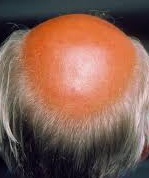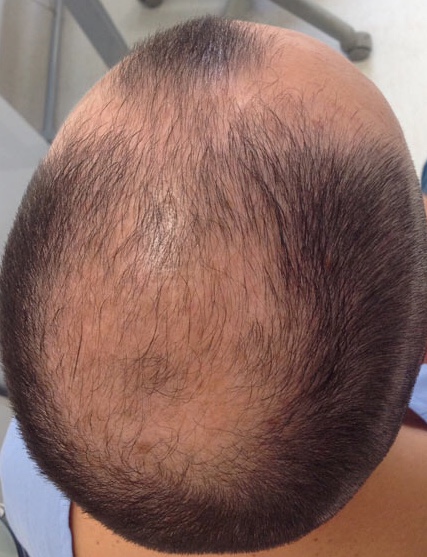[1]
Lolli F, Pallotti F, Rossi A, Fortuna MC, Caro G, Lenzi A, Sansone A, Lombardo F. Androgenetic alopecia: a review. Endocrine. 2017 Jul:57(1):9-17. doi: 10.1007/s12020-017-1280-y. Epub 2017 Mar 28
[PubMed PMID: 28349362]
[2]
Sasaki GH. Review of Human Hair Follicle Biology: Dynamics of Niches and Stem Cell Regulation for Possible Therapeutic Hair Stimulation for Plastic Surgeons. Aesthetic plastic surgery. 2019 Feb:43(1):253-266. doi: 10.1007/s00266-018-1248-1. Epub 2018 Oct 15
[PubMed PMID: 30324295]
[3]
Neuhaus K, Schiestl C, Adelsberger R, Weibel L, Meuli M, Böttcher-Haberzeth S. Bold to do - bald to be? Outcomes decades after harvesting the scalp in burned children. Burns : journal of the International Society for Burn Injuries. 2019 May:45(3):543-553. doi: 10.1016/j.burns.2018.09.023. Epub 2018 Oct 15
[PubMed PMID: 30337156]
[4]
Almohanna HM, Perper M, Tosti A. Safety concerns when using novel medications to treat alopecia. Expert opinion on drug safety. 2018 Nov:17(11):1115-1128. doi: 10.1080/14740338.2018.1533549. Epub 2018 Oct 25
[PubMed PMID: 30318935]
Level 3 (low-level) evidence
[5]
Chan L, Cook DK. Female pattern hair loss. Australian journal of general practice. 2018 Jul:47(7):459-464. doi: 10.31128/AJGP-02-18-4498. Epub
[PubMed PMID: 30114864]
[6]
Tanaka Y, Aso T, Ono J, Hosoi R, Kaneko T. Androgenetic Alopecia Treatment in Asian Men. The Journal of clinical and aesthetic dermatology. 2018 Jul:11(7):32-35
[PubMed PMID: 30057663]
[7]
Hoffmann R, Happle R. Current understanding of androgenetic alopecia. Part II: clinical aspects and treatment. European journal of dermatology : EJD. 2000 Jul-Aug:10(5):410-7
[PubMed PMID: 10882953]
Level 3 (low-level) evidence
[8]
Mahmoudi H, Salehi M, Moghadas S, Ghandi N, Teimourpour A, Daneshpazhooh M. Dermoscopic Findings in 126 Patients with Alopecia Areata: A Cross-Sectional Study. International journal of trichology. 2018 May-Jun:10(3):118-123. doi: 10.4103/ijt.ijt_102_17. Epub
[PubMed PMID: 30034191]
Level 2 (mid-level) evidence
[9]
He H, Xie B, Xie L. Male pattern baldness and incidence of prostate cancer: A systematic review and meta-analysis. Medicine. 2018 Jul:97(28):e11379. doi: 10.1097/MD.0000000000011379. Epub
[PubMed PMID: 29995779]
Level 1 (high-level) evidence
[10]
Bienenfeld A, Azarchi S, Lo Sicco K, Marchbein S, Shapiro J, Nagler AR. Androgens in women: Androgen-mediated skin disease and patient evaluation. Journal of the American Academy of Dermatology. 2019 Jun:80(6):1497-1506. doi: 10.1016/j.jaad.2018.08.062. Epub 2018 Oct 10
[PubMed PMID: 30312644]
[11]
Sadick NS, Callender VD, Kircik LH, Kogan S. New Insight Into the Pathophysiology of Hair Loss Trigger a Paradigm Shift in the Treatment Approach. Journal of drugs in dermatology : JDD. 2017 Nov 1:16(11):s135-s140
[PubMed PMID: 29141068]
[12]
Gupta M, Mysore V. Classifications of Patterned Hair Loss: A Review. Journal of cutaneous and aesthetic surgery. 2016 Jan-Mar:9(1):3-12. doi: 10.4103/0974-2077.178536. Epub
[PubMed PMID: 27081243]
[13]
Naik PP, Farrukh SN. Association between alopecia areata and thyroid dysfunction. Postgraduate medicine. 2021 Nov:133(8):895-898. doi: 10.1080/00325481.2021.1974689. Epub 2021 Sep 6
[PubMed PMID: 34455910]
[14]
Treister-Goltzman Y, Yarza S, Peleg R. Iron Deficiency and Nonscarring Alopecia in Women: Systematic Review and Meta-Analysis. Skin appendage disorders. 2022 Mar:8(2):83-92. doi: 10.1159/000519952. Epub 2021 Nov 19
[PubMed PMID: 35415182]
Level 1 (high-level) evidence
[15]
Cavazos A, Deb A, Pawar D, Sharma U, Pertuz GDR, Pham M, Gutal AG, Winn R. Secondary syphilis presenting with "crown of Venus" alopecia. Proceedings (Baylor University. Medical Center). 2022:35(4):548-549. doi: 10.1080/08998280.2022.2065074. Epub 2022 Apr 27
[PubMed PMID: 35754574]
[16]
Grant JE, Chamberlain SR. Trichotillomania. The American journal of psychiatry. 2016 Sep 1:173(9):868-74. doi: 10.1176/appi.ajp.2016.15111432. Epub
[PubMed PMID: 27581696]
[17]
Adil A, Godwin M. The effectiveness of treatments for androgenetic alopecia: A systematic review and meta-analysis. Journal of the American Academy of Dermatology. 2017 Jul:77(1):136-141.e5. doi: 10.1016/j.jaad.2017.02.054. Epub 2017 Apr 7
[PubMed PMID: 28396101]
Level 1 (high-level) evidence
[18]
Nast A, Gaskins M, Eisert L, Werner RN, Borradori L, Marinovic B, Paul C, Dressler C. Prioritizing topics in guideline development: results of a two-phase online survey of dermatologist members of the EADV. Journal of the European Academy of Dermatology and Venereology : JEADV. 2019 Jan:33(1):227-233. doi: 10.1111/jdv.15282. Epub 2018 Nov 13
[PubMed PMID: 30317678]
Level 3 (low-level) evidence
[19]
Manabe M, Tsuboi R, Itami S, Osada SI, Amoh Y, Ito T, Inui S, Ueki R, Ohyama M, Kurata S, Kono T, Saito N, Sato A, Shimomura Y, Nakamura M, Narusawa H, Yamazaki M, Drafting Committee for the Guidelines for the Diagnosis and Treatment of Male- and Female-Pattern Hair Loss. Guidelines for the diagnosis and treatment of male-pattern and female-pattern hair loss, 2017 version. The Journal of dermatology. 2018 Sep:45(9):1031-1043. doi: 10.1111/1346-8138.14470. Epub 2018 Jun 4
[PubMed PMID: 29863806]
[20]
Hu R, Xu F, Sheng Y, Qi S, Han Y, Miao Y, Rui W, Yang Q. Combined treatment with oral finasteride and topical minoxidil in male androgenetic alopecia: a randomized and comparative study in Chinese patients. Dermatologic therapy. 2015 Sep-Oct:28(5):303-8. doi: 10.1111/dth.12246. Epub 2015 Jun 2
[PubMed PMID: 26031764]
Level 1 (high-level) evidence
[21]
York K, Meah N, Bhoyrul B, Sinclair R. A review of the treatment of male pattern hair loss. Expert opinion on pharmacotherapy. 2020 Apr:21(5):603-612. doi: 10.1080/14656566.2020.1721463. Epub 2020 Feb 17
[PubMed PMID: 32066284]
Level 3 (low-level) evidence
[23]
Hirshburg JM, Kelsey PA, Therrien CA, Gavino AC, Reichenberg JS. Adverse Effects and Safety of 5-alpha Reductase Inhibitors (Finasteride, Dutasteride): A Systematic Review. The Journal of clinical and aesthetic dermatology. 2016 Jul:9(7):56-62
[PubMed PMID: 27672412]
Level 1 (high-level) evidence
[24]
Andy G, John M, Mirna S, Rachita D, Michael K, Maja K, Aseem S, Zeljana B. Controversies in the treatment of androgenetic alopecia: The history of finasteride. Dermatologic therapy. 2019 Mar:32(2):e12647. doi: 10.1111/dth.12647. Epub 2018 Sep 25
[PubMed PMID: 30253001]
[25]
Mysore V. Finasteride and sexual side effects. Indian dermatology online journal. 2012 Jan:3(1):62-5. doi: 10.4103/2229-5178.93496. Epub
[PubMed PMID: 23130269]
[26]
Arif T, Dorjay K, Adil M, Sami M. Dutasteride in Androgenetic Alopecia: An Update. Current clinical pharmacology. 2017:12(1):31-35. doi: 10.2174/1574884712666170310111125. Epub
[PubMed PMID: 28294070]
[27]
Fertig RM, Gamret AC, Darwin E, Gaudi S. Sexual side effects of 5-α-reductase inhibitors finasteride and dutasteride: A comprehensive review. Dermatology online journal. 2017 Nov 11:23(11):. pii: 13030/qt24k8q743. Epub 2017 Nov 11
[PubMed PMID: 29447628]
[28]
Nestor MS, Ablon G, Gade A, Han H, Fischer DL. Treatment options for androgenetic alopecia: Efficacy, side effects, compliance, financial considerations, and ethics. Journal of cosmetic dermatology. 2021 Dec:20(12):3759-3781. doi: 10.1111/jocd.14537. Epub 2021 Nov 6
[PubMed PMID: 34741573]
[29]
Wang C, Du Y, Bi L, Lin X, Zhao M, Fan W. The Efficacy and Safety of Oral and Topical Spironolactone in Androgenetic Alopecia Treatment: A Systematic Review. Clinical, cosmetic and investigational dermatology. 2023:16():603-612. doi: 10.2147/CCID.S398950. Epub 2023 Mar 9
[PubMed PMID: 36923692]
Level 1 (high-level) evidence
[30]
Trinchieri A, Perletti G, Magri V, Stamatiou K, Trinchieri M, Montanari E. Drug-induced gynecomastia: A systematic review and meta-analysis of randomized clinical trials. Archivio italiano di urologia, andrologia : organo ufficiale [di] Societa italiana di ecografia urologica e nefrologica. 2021 Dec 21:93(4):489-496. doi: 10.4081/aiua.2021.4.489. Epub 2021 Dec 21
[PubMed PMID: 34933535]
Level 1 (high-level) evidence
[31]
Fabbrocini G, Cantelli M, Masarà A, Annunziata MC, Marasca C, Cacciapuoti S. Female pattern hair loss: A clinical, pathophysiologic, and therapeutic review. International journal of women's dermatology. 2018 Dec:4(4):203-211. doi: 10.1016/j.ijwd.2018.05.001. Epub 2018 Jun 19
[PubMed PMID: 30627618]
[32]
Vexiau P, Chaspoux C, Boudou P, Fiet J, Jouanique C, Hardy N, Reygagne P. Effects of minoxidil 2% vs. cyproterone acetate treatment on female androgenetic alopecia: a controlled, 12-month randomized trial. The British journal of dermatology. 2002 Jun:146(6):992-9
[PubMed PMID: 12072067]
Level 1 (high-level) evidence
[33]
Gupta AK, Mays RR, Dotzert MS, Versteeg SG, Shear NH, Piguet V. Efficacy of non-surgical treatments for androgenetic alopecia: a systematic review and network meta-analysis. Journal of the European Academy of Dermatology and Venereology : JEADV. 2018 Dec:32(12):2112-2125. doi: 10.1111/jdv.15081. Epub 2018 Jul 11
[PubMed PMID: 29797431]
Level 1 (high-level) evidence
[34]
Bater KL, Ishii M, Joseph A, Su P, Nellis J, Ishii LE. Perception of Hair Transplant for Androgenetic Alopecia. JAMA facial plastic surgery. 2016 Dec 1:18(6):413-418. doi: 10.1001/jamafacial.2016.0546. Epub
[PubMed PMID: 27560098]
[35]
Katzer T, Leite Junior A, Beck R, da Silva C. Physiopathology and current treatments of androgenetic alopecia: Going beyond androgens and anti-androgens. Dermatologic therapy. 2019 Sep:32(5):e13059. doi: 10.1111/dth.13059. Epub 2019 Aug 26
[PubMed PMID: 31400254]
[37]
Abdel Fattah NS, Darwish YW. Androgenetic alopecia and insulin resistance: are they truly associated? International journal of dermatology. 2011 Apr:50(4):417-22. doi: 10.1111/j.1365-4632.2010.04677.x. Epub
[PubMed PMID: 21413951]
[38]
Sadgrove NJ. The new paradigm for androgenetic alopecia and plant-based folk remedies: 5α-reductase inhibition, reversal of secondary microinflammation and improving insulin resistance. Journal of ethnopharmacology. 2018 Dec 5:227():206-236. doi: 10.1016/j.jep.2018.09.009. Epub 2018 Sep 6
[PubMed PMID: 30195058]
[39]
Amoretti A, Laydner H, Bergfeld W. Androgenetic alopecia and risk of prostate cancer: a systematic review and meta-analysis. Journal of the American Academy of Dermatology. 2013 Jun:68(6):937-43. doi: 10.1016/j.jaad.2012.11.034. Epub 2013 Feb 8
[PubMed PMID: 23395589]
Level 1 (high-level) evidence
[40]
Gül U, Kiliç A, Akbaş A, Aslan E, Demiriz M. Alopecia neoplastica due to metastatic colon adenocarcinoma. Acta dermato-venereologica. 2007:87(1):93-4
[PubMed PMID: 17225030]
[41]
Resorlu M, Sancak EB, Uysal F, Arslan M, Diri A, Adam G, Akbas A, Sariyildirim A, Gulpinar MT, Resorlu B. The association of urolithiasis and androgenetic alopecia. Renal failure. 2016:38(1):84-8. doi: 10.3109/0886022X.2015.1096729. Epub 2015 Oct 13
[PubMed PMID: 26460579]
[42]
Lee S, Kim BJ, Lee YB, Lee WS. Hair Regrowth Outcomes of Contact Immunotherapy for Patients With Alopecia Areata: A Systematic Review and Meta-analysis. JAMA dermatology. 2018 Oct 1:154(10):1145-1151. doi: 10.1001/jamadermatol.2018.2312. Epub
[PubMed PMID: 30073292]
Level 1 (high-level) evidence
[43]
Giordano S, Romeo M, di Summa P, Salval A, Lankinen P. A Meta-analysis On Evidence Of Platelet-rich Plasma for Androgenetic Alopecia. International journal of trichology. 2018 Jan-Feb:10(1):1-10. doi: 10.4103/ijt.ijt_74_16. Epub
[PubMed PMID: 29440850]
Level 1 (high-level) evidence


